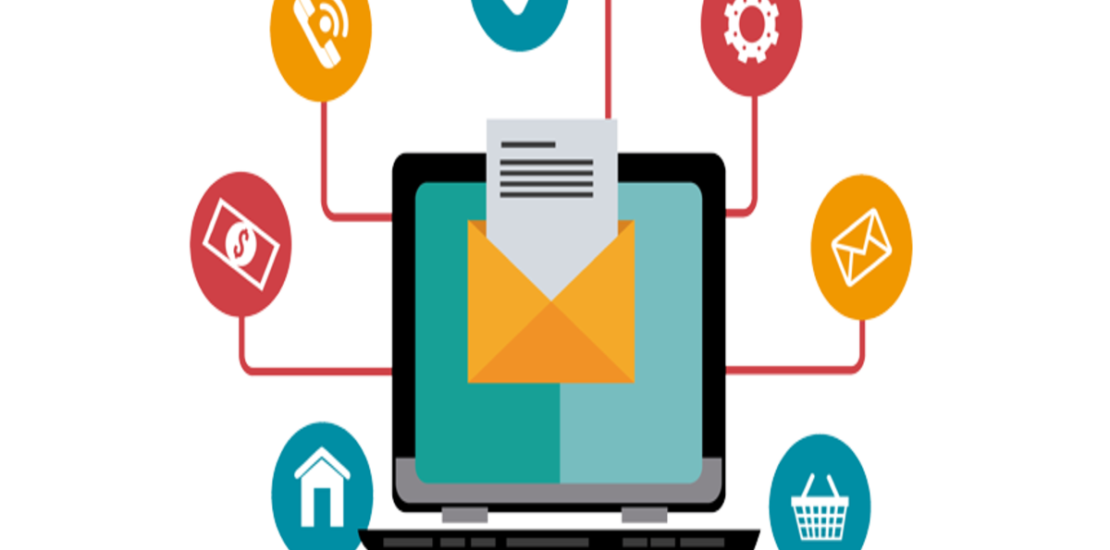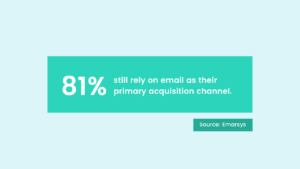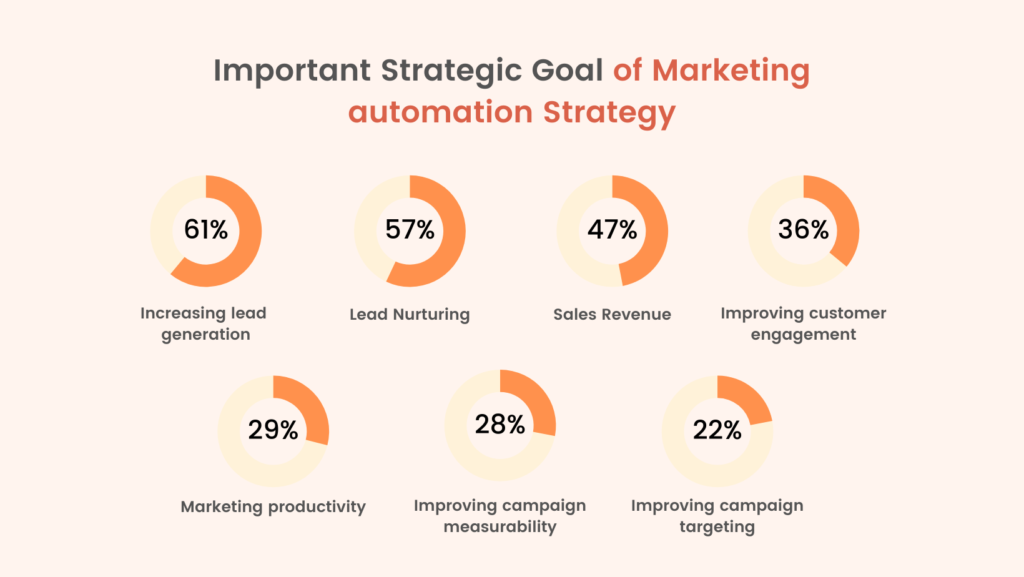- January 30, 2022
- Posted by: Christina Milian
- Category: blog

Over the years, a lot has been changed for email. From just sending a message to businesses using it as the most cost-effective way of direct marketing. According to reports, more than 80% of SMEs depend upon email marketing for their primary customer acquisition channel. With the advent of digitalization, the incoming of data through various social media platforms and mobile devices paved the way for collecting and managing data.

Source: Emarsys
Such importance on data has increased the demand for Automation and behavioral-led programs focused on customers’ specific needs. All these demands have contributed to Marketing Automation.
Email Marketing and Marketing Automation: What’s More?
So, the question here is why do businesses still need email marketing? When marketing automation can automate the marketing tasks. Now, the companies must understand which entity benefits, how, and when to switch.
While both email marketing and marketing automation target major audience groups. Let’s first understand what email marketing and marketing automation are.
Marketing automation is the technology that propels your business into a new era of relationship-based marketing with quantifiable results. When powerful technology meets effective implementation and internal process management, your company will soon find itself on a journey that leads to new heights of business success.
~ Jon Miller
Email Marketing:
Email marketing refers to a digital marketing strategy to generate leads or sell products and develop relationships with prospects and customers via email. It involves building a list of emails maintaining the database of current customers, subscribers, and potential leads.
An effective email strategy involves converting prospects into customers and turning first-time buyers into recurring customers.
In fact, according to Content Marketing Institute Report 2020, 85% of marketing professionals use email marketing software for marketing automation.

Source: Content Marketing Institute
You can set up an opt-in page with a form where people can exchange their email ID in return for a gift, a mini-course, or perhaps valuable information in the condition of a white paper or eBook.
Email marketing often requires manual tasks. Platforms like mail and other providers give you minimal email tools offered with limited Automation, such as sending out emails to multiple recipients using CC or BCC rather than typing each one’s name. So, an individual starting with email marketing will have to handle campaigns themselves.
Nowadays, email marketing automation is more advanced.
For example, it offers tracking insights about your subscriber opt-ins and open rates.
Marketing Automation:
Marketing automation refers to applying software or system to automate marketing activities. Automation lets you perform your tasks more efficiently. Marketing departments implement automation to carry out repetitive tasks such as ad campaigns, email marketing, and social media postings.
According to Invespro, 63% of marketers plan to increase their marketing automation budget this year.

Automation not just boosts efficiency but also provides customers more personalized experience. The use of superior automated technology and strategy can define marketing automation and converts your prospects into delighted customers. Types of software that can automate marketing tasks include CRM (Customer Relationship Management) and AI (Artificial Intelligence).
Some examples of how marketing automation can boost your efficiency are as follows:
- Nurture your leads: Helps analyze best tips and determines strategies to categorize and nurture them.
- Increase social media marketing: multiple posting s on social media can be catered through marketing automation.
- Tracking and analytics for first-time website visitors and campaigns and online promotions.
Also read: How direct mail marketing helps businesses to connect with more customers.
Strategies for Automating Email Marketing
Few strategies for email marketing automation that can make your campaigns more successful are:
- Personalize your messages: Personalizing manually is a time-consuming process. Implementing Email services and auto-responders may optimize personalization in the manner of your choice. For example: Using a contact’s name or personal signatures.
- Drip feed emails. Sending emails on a schedule as a series of daily or weekly lessons to understand whether your subscriber is in your sales funnel.
- Trigger emails. Welcome emails for new subscribers or emails sent on special occasions such as holidays or birthdays are trigger emails that help retain your customers. Retargeting your customer is another example of automatically sending an email to the person who visited your website.
- Segmentation. When the list of emails grows, it’s good to segment them to send them the most relevant information. Through Automation, you can segment your customers according to their buying actions, location, demographic data, or location.
Know the Difference between Email Marketing and Marketing Automation?
1. Behavior tracking: Email vs. Web
Most of the differences from the data collected from both platforms. Does email marketing automation help track a recipient’s behavior, like the customer read your email? Or do they visit the link provided? Which link have they seen more? You can get aggregate data on this, with which you can calculate the percentage of people who used your email or who did not.
They did download an e-book, open an infographic, watch a webinar, etc. it provides a complete picture of each lead’s journey through your funnel. Whereas, with marketing automation, you get much more than email data. It helps track your lead’s behavior everywhere.
2. Monotonous Path vs. Flexible Customer-Centered Messaging
Email marketing is time-consuming and requires a significant investment of time- right from email creation to list segmentation and post-delivery analytics. Once you have built a list, implementing a sophisticated email marketing automation tool can help you send the same email to different segments of your list. People in other elements get slightly different messages or offers with dynamic content applications.
On the other hand, marketing automation also requires lots of hands-on work upfront. However, the return is more here. Here you can build automated programs with more choices. For example, you can use drip campaigns that send a series of messages over time and follow-up communications depending on how a prospect interacts with your messages. You can also track engagement metrics and qualification levels and create dynamic campaigns that follow the actions of individual leads helping the marketer make the customer the center of the campaign experience.
3. Steady Information vs. Robust Lead Scoring
Lead scoring can be done through marketing automation, whereas Email marketing tools provide information about the leads, often contact information. This means you may not be able to gather many insights without a separate analytics tool.
Marketing automation helps collect data and score your leads based on their firmographics data and behavioral cues.
For example, if your customers are from companies of a specific size, you can create a form asking to what extent is your company? Also, if you are well aware of the people who can convert into potential leads after watching your webinar, you can score the action of watching that webinar. This will result in better charges generating higher scores.
4. Assuming vs. Attribution of the Revenue
When you send an email to the potential lead via an email service provider, you can know whether the information clicked on a link with a call-to-action purchase. You can also use a CRM to check whether that lead is your customer or has become one. However, making a purchase does not essentially mean that the customer purchased because of your email. The customer might have engaged with a dozen additional touchpoints and assets on your site.
You can map your customer behavior with marketing automation instead of making assumptions. With marketing automation, you can track a lead’s entire journey and get information about the lead and reason behind their purchase by following the exact path, including any subsequent actions taken apart from email. It can also help drive activities and assets by converting leads into sales.
5. Simple Automation vs. Intelligent Follow-up
The capabilities of most modern email marketing tools depend on the platform used. For example: sending out email blasts in advance for specific dates, or in more advanced marketing automation platforms, you also get transactional triggers, the ability to apply segmentation rules, and the capability to create nurturing programs according to different time zones.
Marketing automation allows marketers to coordinate and manage all of their communications with multiple stakeholders simultaneously inside the same company, thus facilitating account-based marketing.
Marketing automation is the next-level system based on behavioral analysis. It can optimize the leads, timing of contact, message shared, and even create suggestions for offline contact such as phone calls or direct mail.
The Advantages of Combining Email Marketing and Marketing Automation
Email marketing and marketing automation are different from each other, but they make a powerful combination when combined. Email marketing can be more powerful and targeted by implementing drip campaigns and retargeting. To develop stronger relationships with your subscribers, you can research and test more automation strategies.
Email Marketing or Marketing Automation: Which one Matters?
Email marketing and marketing automation platforms can serve as valuable platforms for any marketer to start and make connections with the people in their lead base. Choosing which type of tool is right for your business depends on your goals and how much you want to accomplish with your leads.
For example, in a simple sales cycle, you don’t need a lot of attention, and maybe a newsletter or a few promotional blasts- an email marketing automation solution might be enough.
On the other hand, if you want to nurture, score and qualify your leads based on their engagement with your brand, you can choose marketing automation. So, selecting an email marketing or marketing automation in both cases depend on the scope of your product offering, quantity and diversity of your leads, and the speed of your customer journey.

